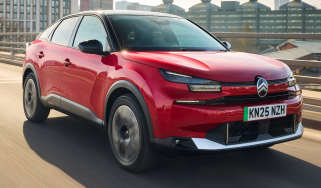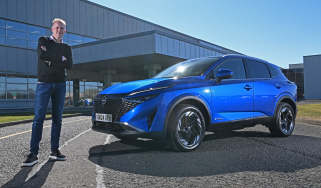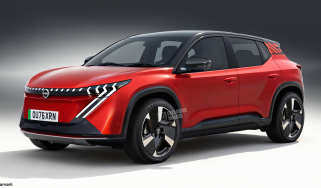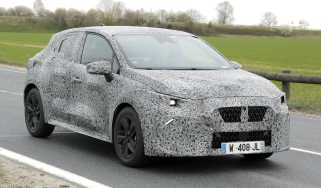Volkswagen Golf - Engines, performance and drive
The VW Golf is a decent all-rounder, and that hasn’t been altered with the revisions for the Mk8.5 model

While the eighth-generation Volkswagen Golf had one or two flaws when it was launched, a lack of diversity in its range was certainly not one of them. A vast array of powertrain options has always been on the table, and that trend continues with the revised model.
The options have changed slightly, though. There was a time when downsizing was all the rage among car brands, slipping smaller engines into cars and compensating with turbocharging to make up for the capacity deficit, but this often resulted in an engine that could be a little overworked (and, therefore, less frugal) in the real world.
Things have now changed, with one such engine, the 1.0-litre three-cylinder turbo petrol, now replaced with a new version of the 1.5-litre four-cylinder TSI. This motor produces 114bhp and 220Nm of torque; not only is that latter number 20Nm more than the outgoing three-cylinder, but the 1.5-litre achieves maximum torque at lower revs than the old 1.0-litre engine. Above that model sits our choice, the more familiar 148bhp/250Nm variant. Models fitted with an auto get mild-hybrid tech with an electric motor to take some load off the engine when accelerating.
The plug-in hybrid range has also grown. Literally, in the case of the battery; the new unit is bumped up to 19.7kWh of useable battery capacity, enabling the Golf to offer up to 88 miles of electric range on a single charge from the eHybrid version. Power outputs range from 201bhp to 268bhp, with the latter reserved for the sporty GTE model.
Used - available now
Above the GTE sits a line-up of even more performance-focused choices. The iconic Volkswagen Golf GTI has been given a power boost to 262bhp, while the hot Volkswagen Golf R version now produces 329bhp, which it sends to all four wheels.
As the more financially frugal side of the family, Volkswagen is still offering buyers the option of diesel. A 2.0-litre unit is available, with power outputs of 113bhp and 148bhp, the latter with an automatic gearbox.
|
Model |
Power |
0-62mph |
Top speed |
|
Golf 1.5 eTSI 150 Life DSG |
148bhp |
8.4 seconds |
139mph |
|
Golf 2.0 TDI Match |
114bhp |
10.2 seconds |
126mph |
|
Golf 1.5 GTE |
268bhp |
6.6 seconds |
143mph |
What is the Volkswagen Golf like to drive?
In town
Undoubtedly, the most important quality of a family hatchback drives is its ease of use, and more than ever, the Golf is a car anyone can hop into and just immediately feel comfortable with.
The mild-hybrid technology on the 1.5 e-TSI smooths out some of the rough patches that we’ve previously noticed with VW’s DSG gearbox – particularly when moving off or reversing into a tight parking space. In comparison, the TDI diesel auto without the MHEV system still suffers from a touch of jerkiness, but the generous low-down torque means that the gearbox doesn’t need to kick down quite as often.
The Golf’s steering is nicely weighted and fairly precise, but it doesn’t offer much feedback and is quite slow off-centre, which in some situations means that the Golf doesn’t feel like the most agile hatchback on the market.
On A- and B-roads
One of the VW Golf’s strengths has always been to offer a chassis compromise that delivers competent (if not class-leading) body control through corners without letting the ride comfort fall apart on a bumpy road.
Those characteristics continue with the updated Mk8.5; it’s not the firmest model in its class by a long stretch, but there’s sufficient control for big bumps to be dealt with in a single bounce of the springs.
While some rivals handle more sharply on smooth surfaces, the Golf’s set-up is very well judged for Britain’s bumpy roads. The balance is impressively neutral, and grip, especially on the front axle, is strong for the class.
On the motorway
The Golf isn’t quite the most refined car in its segment at speed – the Peugeot 308 has it narrowly beaten here, thanks to a touch less road noise – but the VW’s high-speed stability is class-leading. A strong engine line-up also works in its favour at higher speeds. Across the board, the power delivery is smooth and the engines are refined – even the diesels are muted under load.
0-62mph acceleration and top speed
The engine line-up for the front-wheel-drive Golf includes TSI petrol and TDI diesel engines. The entry-level 1.5-litre that replaces the older 1.0-litre three-cylinder petrol offers 114bhp – up from 109bhp – and has extra torque, so it manages a 0-62mph time of 9.9 seconds, which is three-tenths of a second faster than the 1.0 TSI.
The more powerful 148bhp 1.5 TSI (the 128bhp version has been dropped) has a 0-62mph time of 8.5 seconds. Both of these 1.5 TSIs use a six-speed manual gearbox, while there’s also a 148bhp eTSI, with mild-hybrid tech and a seven-speed DSG automatic gearbox. Cylinder deactivation, which shuts down two of the four cylinders when cruising to save fuel, is also fitted, but you’ll hardly notice when this occurs as the system operates so seamlessly.
Performance from the GTE plug-in hybrid is pretty rapid, with the 0-62mph dash taking just 6.6s, while the GTI model is even quicker at 5.9s. Volkswagen quotes 0-62mph times for the 113bhp and 148bhp diesels, as 10.2s and 8.0s, respectively.
At the top end of the range, the Volkswagen GTI Clubsport races to the same benchmark in 5.6s, while the hot R is a second quicker with a time of 4.6 seconds.














